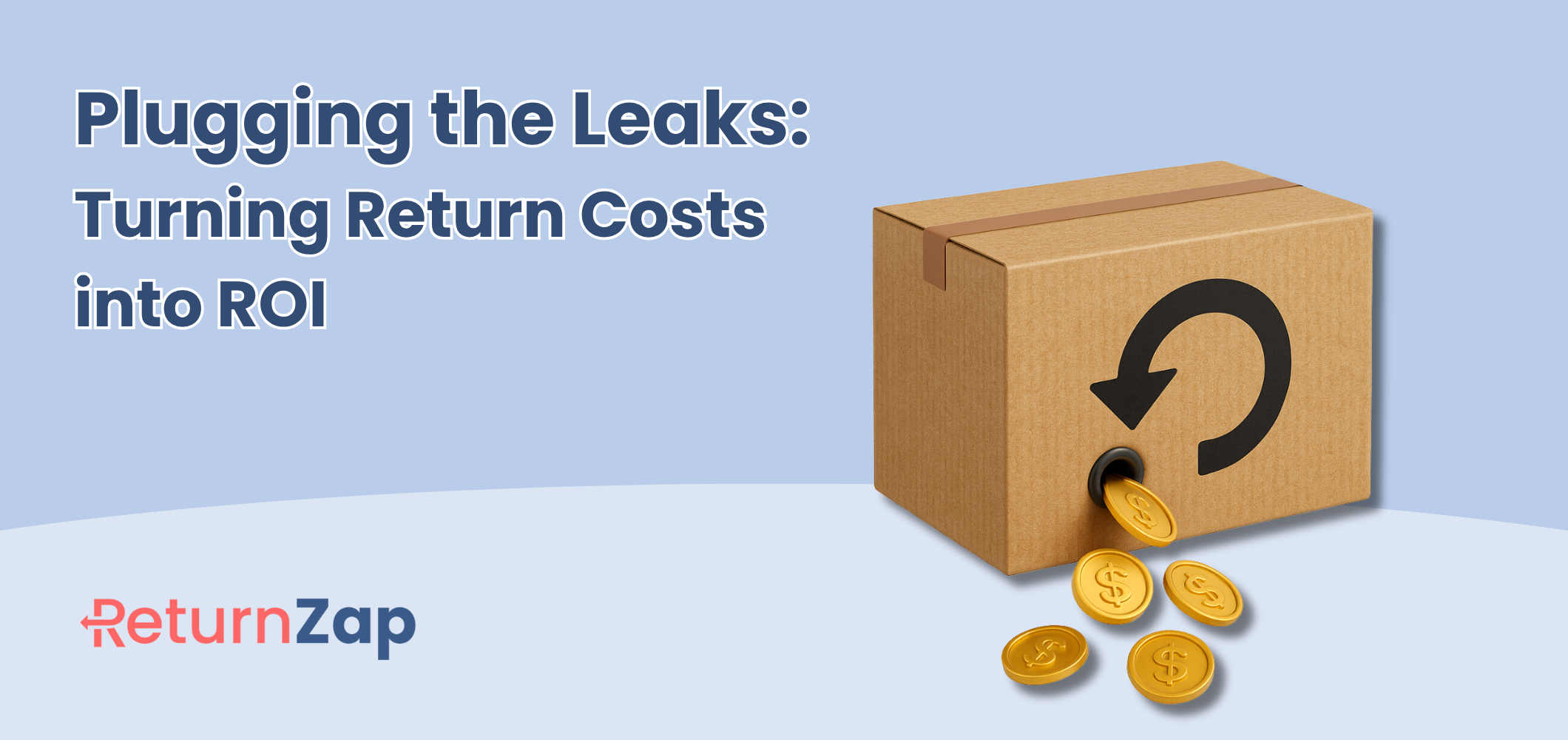Shopify Return Rate Benchmarking

Why E-Commerce Return Rates Matter In 2024
Successfully managing customer returns is a huge part of selling online. Over $420 billion dollars of merchandise was returned to brick and mortar and e-commerce retailers in 2020 - over 10.6% of total retail sales, according to the National Retail Federation.
And that return rate has only grown, as the impact of COVID has shifted more consumer buying behavior online. NRF further estimated that the average return rate grew to 16.6% in 2021.
It's important to note that these are industry-wide averages, across both in person and online sales. There is significant variability from merchant to merchant and between categories. We will get into the complexities below, but it is clear that managing your Shopify return rate is key to building a successful business.
Do you have a returns problem? What is a good Shopify return rate? Read on to find out.

Average Return Rates Do Not Tell The Whole Story
The average return rate for retailers in 2021 was 16.6%. But this number is meaningless for an individual retailer. That includes all retail, in all categories. Apparel and accessories, electronics, furniture, books, etc, all lumped into one. Unless you're a general retailer like Amazon or Walmart, you need more granular return rate data so you can compare your individual store's performance.
You need to benchmark your customer return rates against other similar merchants to understand where you sit. One way to do this is to find like minded retailers and discuss. Join online groups for retailers - Facebook, LinkedIn, etc and industry specific trade groups. Attend in person or virtual trade shows and discuss. You'll be amazed at what you can learn just by asking.

How to Calculate Your Average Return Rate
Before you can compare your return rate to others, a critical first step is to understand your returns data. You can often do this simply, by exporting a list of your returns and using a tool like Microsoft Excel to compare return rate to order details.
By using a Shopify returns app like ReturnZap, you can easily export detail on all of your returns for analysis.
What is a Returns Cohort Analysis
When calculating your return rate, it is important to apply the concept of cohorted sales to arrive at an accurate number. Especially in businesses with high seasonal variability, it is not enough to look at total returns over a period divided by total returns over a period.
You need to match customer returns to order date in order to arrive at an accurate return rate for your store. You should also give enough time for all returns to come in from a given sales period before calculating your true return rate. This will vary and depends on your return policy.
How to Calculate Return Rates - An Example
Let's say you want to calculate your return rate for the month of January.
First: consider your store's return policy. If you allow returns and refunds for 30 days after purchase, you should wait until at least early March to tabulate all returns from those January sales and arrive at a return rate. This will give time for all returns and refunds to be processed.
Second: Export a reporting containing all returns and refunds for the orders placed Jan 1 - Jan 31st. You can do this directly from Shopify, or you can use a 3rd party application. Details on generating reports within Shopify can be found here.
Third: Divide the total dollars refunded for sales Jan 1 - Jan 31 by the total sales for that time period to arrive at a return rate for January.

E-Commerce Return Rate Statistics
Now that you have an idea of the return rate for your Shopify store, you can make a meaningful comparison to industry benchmarks.
Various industry groups have published statistics around average return rates by category. We have summarized key findings here.
National Retail Federation Returns Benchmarking
The NRF and Appriss Retail conducted a survey of retail return rates in 2020. They reported return rates for several categories of retailers:
- Apparel - 12.2%
- Auto parts - 19.4%
- Beauty - 4.3%
- Department Stores - 11.4%
- Drug / Pharmacies - 1.6%
- Footwear - 9.1%
- Hard Goods - 3.8%
- Home Improvement - 11.5%
- Housewares - 11.5%
- Sporting Goods - 7.6%
The report found an overall return rate of 10.6%. But things are getting worse! The average retail return rate jumped to 16.6% in 2021. And online sales are even worse. The same report estimates the return rate for online purchased to be over 20%. With return rates growing, it is increasingly important to have a clear returns policy and a streamlined approach to managing your returns process. It also presents an opportunity to engage with your customers and to turn a negative experience (a product that didn't work out) into a positive one:
“Retailers view the return process as an opportunity to further engage with customers, as it provides additional points of contact for retailers to enhance the overall consumer experience."
Mark Mathews - NRF Vice President of Research Development and Industry Analysis
McKinsey Study - Apparel Return Rates
A 2021 study by the consulting company McKinsey found that overall e-commerce returns averaged 20%.
So, a retailer doing $1M in annual sales can expect $200k in returned merchandise.
The same study found that apparel retailers have even higher rates of return at 25%. This is not surprising considering the unique challenges facing the apparel sector - consumers often buy multiple different sizes of the same item in order to return the ones that don't fit the best.
Shippo E-Commerce Benchmarks Report
Shipping aggregator Shippo published a report detailing industry benchmarks for 2020. They calculated return rates for various industry by analyzing the percentage of prepaid return labels that were ultimately used to send back a return.
While not limited to Shopify retailers, these are e-commerce return rates which should apply generally across platforms.
- Apparel - 10.0%
- Beauty - 5.0%
- Health & Wellness - 4.2%
- Electronics - 8.3%
- Jewelry - 8.3%
- Sports & Outdoors - 6.1%
Case Study - Large General Merchandise Retailer

A large general merchandise retailer doing over $1B in annual e-commerce sales realized around 2015 that they had a returns problem. Their overall return rate was approaching 10%. This in and of itself was not terrible, but this retailer operated on razor thin margins and returns were significantly impacting profitability.
This retailer made a major push to address perceived product quality issues across its assortment. Over the course of 2 years, it rolled out several industry best practices to reduce the overall rate of return and retain more of its revenue:
- Increased transparency and visibility of user submitted product reviews
- Acted quickly to de-list and remove products with poor reviews, and proactively engaged with customers who were experiencing problems
- Created a rigorous process to track analytics from returns and feed that back into the merchandising process
- Cut off 3rd party vendors who were providing low quality products that were leading to returns
- Implemented a mandatory return to vendor policy for high ticket, high return categories like jewelry to incentivize drop ship suppliers to provide the highest quality merchandise and avoid the cost of returns
Through these efforts, this retailer was able to reduce its overall return rate to an astounding 4.5% with no negative impact to top line sales.
Shopify Merchant Return Rate Averages

Using our own data, ReturnZap has created an anonymized data set of Shopify merchants to break down average return rates by category.
We have broken results down across the following categories:
- Apparel & Accessories
- Electronics
- Footwear
- Health & Beauty
- Home
- Jewelry
- Other/Specialty (Eg: pets, specialty products and accessories for niche markets)
- Toys/Games/baby
Shopify Return Rate Benchmarking Results:
Return rates depend on a variety of factors. These numbers are intended only as guidelines to help inform your benchmarking and policy creation.
This data includes average return rates and, where applicable, minimum and maximum merchant return rates within the category. Min and max have only been included when there are enough data points to allow for anonymous reporting.

What Is A Good Shopify Return Rate?
The answer is of course that it depends! Each Shopify merchant has unique return policies and procedures that will impact return rates.
From the data above, we can see that many Shopify retailers have lower return rates than broader e-commerce averages. It is difficult to say why this is, but a few possible reasons include:
- More restrictive returns policies
- More direct control over product quality, leading to fewer returns
- Less consumer bias towards returns when dealing with smaller retailers / small businesses
You should never set a goal of eliminating all customer returns. It is best to allow customers some flexibility, or else you risk harming your sales numbers.
The optimal return rate also comes down to other factors within your business, such as your average margin and whether you are able to re-sell items that are returned to you.
Making The Most Of Customer Returns
In conclusion, Shopify merchants see a wide range of return rates depending on factors like shop category, return policies, and overall product quality.
Categories like apparel and footwear, where fit and style are paramount, often see the highest levels of returns. But you can see from the data that even within these categories there is a broad range depending on each shop.
ReturnZap has compiled several third party studies, and created a report of return rates based on our own internal data. You can use this information to guide your Shopify return policies and benchmark your Shopify return rate.
Start Your Free ReturnZap Trial Today
Join hundreds of other Shopify merchants successfully managing their returns with ReturnZap




